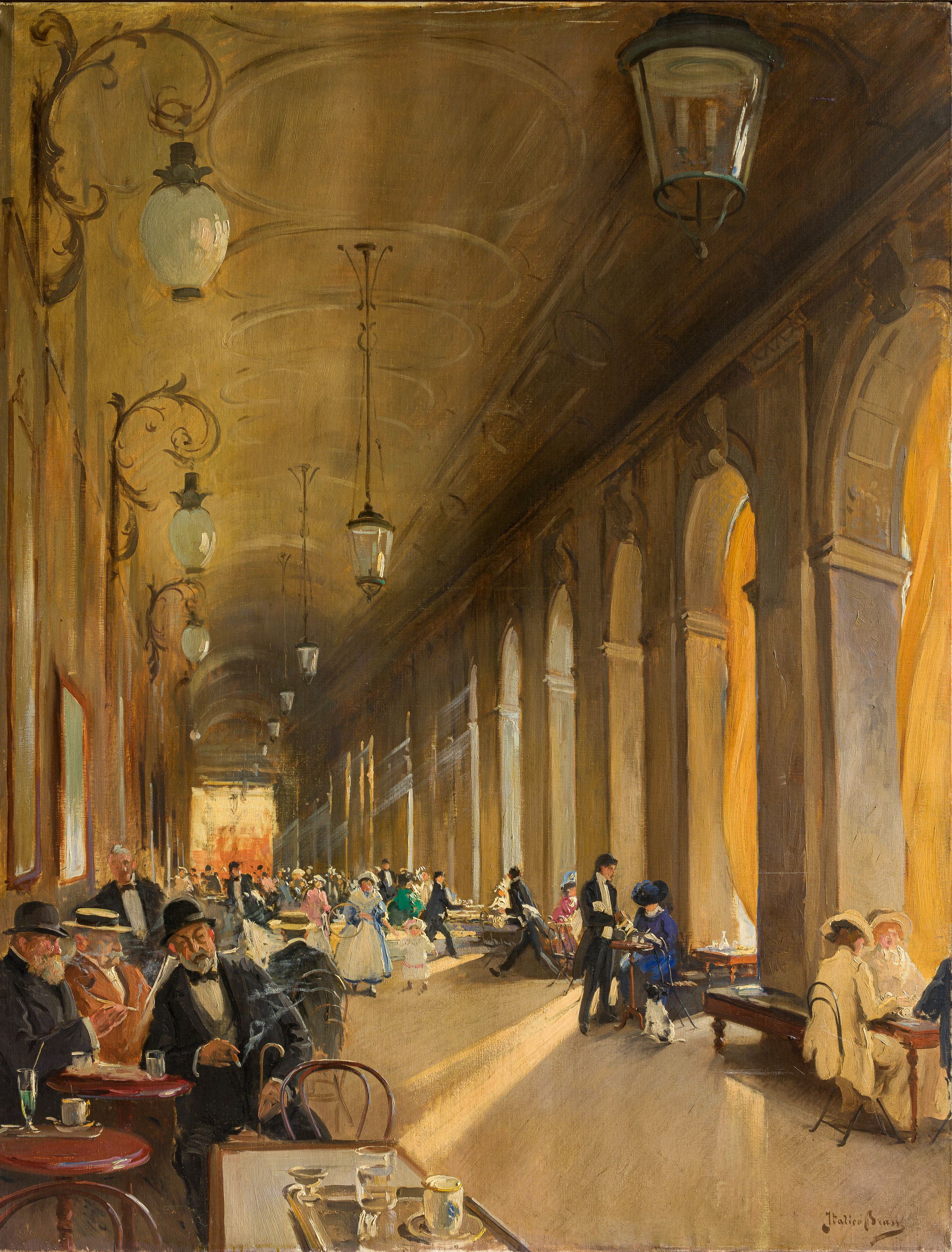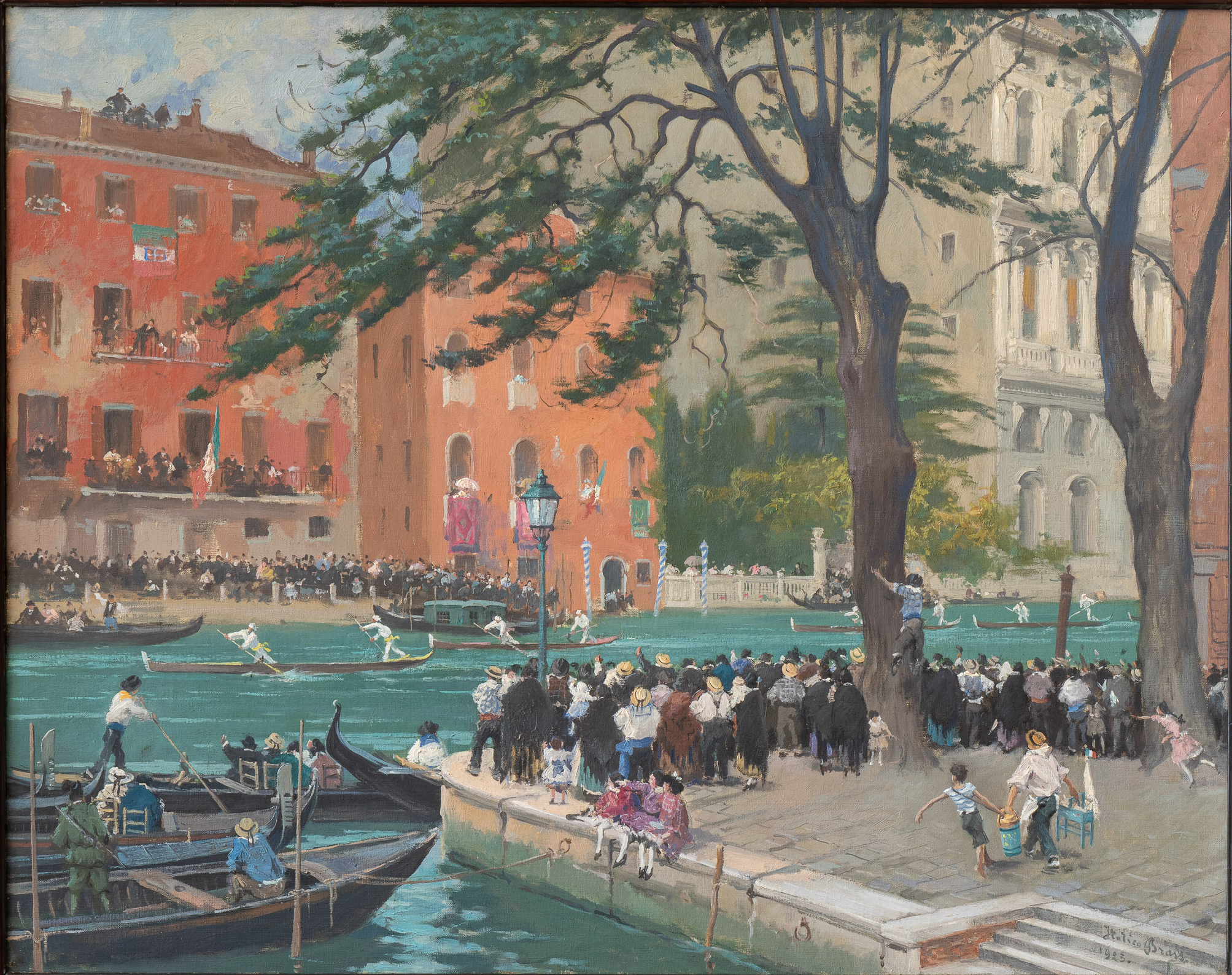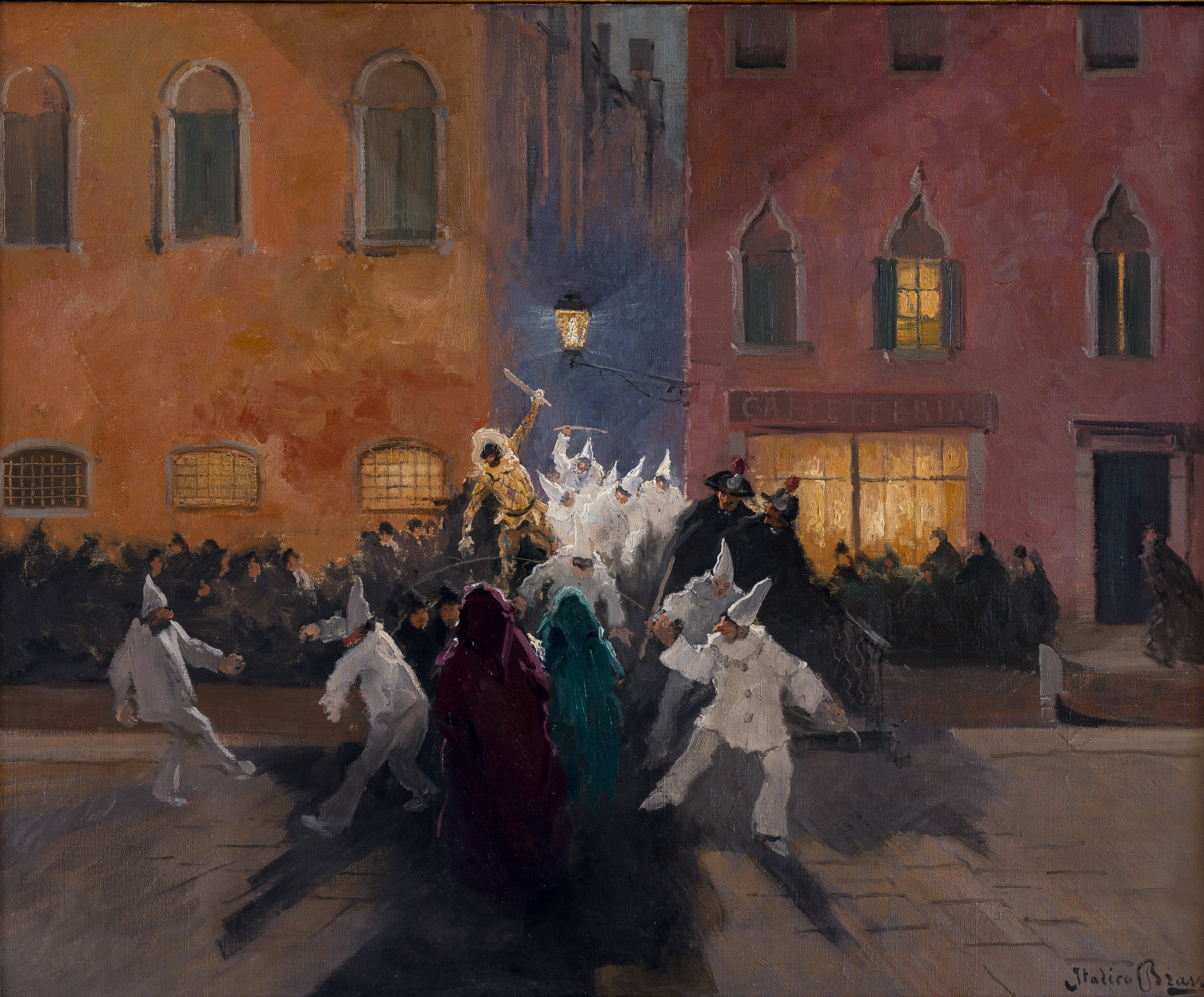
Italico Brass, Al caffè Florian, 1912. Olio su tela, 150 x 116 cm. Collezione privata. Courtesy lineadacqua
Have you ever heard of Italico Brass, the painter who crossed epochs and borders, famous in life but then forgotten for decades?
The life and works of Italico Brass tell a story of success, but fate decided that for decades his great talent, his adventurous life as a war “reporter” and his Venice, which he chose as his point of arrival and indispensable horizon, would not be spoken of again.
In this post I tell you his story, also through some of his most beautiful works.
Life and works of Italico Brass, an artist to rediscover

Italico Brass, La regata,1923. Olio su tela, 75 x 99 cm. Collezione privata.. Courtesy lineadacqua
Born in the heart of Europe on 14 December 1870, in Gorizia, Italico Brass was raised in a strongly patriotic family. His father, a wine merchant, nurtured the aspiration that Gorizia might one day join Italy, a wish Italico carried in his heart throughout his life. Despite having already chosen Venice as his second home, Italico renounced his Austrian passport in 1911 and obtained Italian citizenship in 1916.
PARIS, VENICE AND ARTISTIC MATURITY
From an early age, Italico Brass showed an innate talent for the visual arts. This passion led him to Munich, to the then renowned Academy of Fine Arts, where he was a pupil of the famous Karl Raupp. However, his stay in Germany was short, and in 1888 he moved to the artistic capital of the time, Paris.
In Paris, Brass came into contact with an effervescent and cosmopolitan cultural environment. During his time in the Ville Lumière, interspersed with frequent returns home and sojourns in the city of Venice that he loved so much, Brass gained significant recognition.
His notable works, ‘La Chioggiotta’ and ‘La Briscola’, included a prize at the Paris Salon in 1893. During these years he also met Lina Rebecca Vidoff, a Russian medical student to whom he married in 1895, shortly before moving to Venice for good.
A CAREER ON THE RISE
Success followed Italico Brass like a faithful shadow. He participated in numerous editions of the Venice Biennale, was successful in exhibitions in Turin, Milan and even overseas. In 1900, he won a bronze medal at the Universal Exhibition in Paris with the portrait of his wife, while other paintings of his were acquired by prestigious museums such as Ca’ Pesaro in Venice and the Musée de Luxembourg.
He took part in two Brera Triennials of Fine Arts in Milan and numerous Fine Arts Exhibitions in Turin and Milan; he was also present at the International Fine Arts Exhibitions in Rome in 1908, 1910 and 1911.
He had many exhibitions abroad: at the International Exhibitions at the Glaspalast in Munich in 1897, 1901 and 1913, as well as in London in 1902 at the Lefevre Gallery in King’s Street; then at the International Exhibition in Buenos Aires and the Brussels Exhibition. In Paris in 1914 he enjoyed great success exhibiting 139 works at the Galerie Georges Petit. In that same year he participated with artists of common Friulian origin in the I Biennale of Trieste, organised by the Circolo Artistico.
ENGAGEMENT IN WORLD WAR I AND HONOURS
During the World War, Brass did not remain inactive and worked on behalf of the Supreme Command and the Regia Marina, producing a series of sketches from the front. Thereafter, his participation in national and international exhibitions continued unabated, even winning prestigious honours such as the gold medal at the Jubileum Ausstellung des Kunstlerhaus in 1936.
THE LAST YEARS AND THE LEGACY
Despite a nature described as austere, Italico Brass remained actively involved in the cultural life of Venice. He also devoted himself to the preservation and study of ancient Italian art, of which he was a great enthusiast.
In Venice, he also bought and engaged in the lengthy restoration of the dilapidated and half-abandoned Abbazia Vecchia della Misericordia, which became the seat of his atelier and his famous collection of antique art (to him, who was also an art dealer, is credited, among other things, with the rediscovery of artists such as Magnasco in collaboration with Benno Geiger and the enhancement of authors such as Arcimboldo and Pordenone), as well as the fascinating and ascetic meeting place for artists, journalists, intellectuals and notables. The lagoon city: a place of life and inspiration.
Italico Brass died suddenly in August 1943 in his Venetian home.
THE WORKS OF ITALIC BRASS
After his death, he was practically forgotten for decades.
There is no real reason for this, but in fact no one ever spoke of Italico Brass again and his works were hardly ever exhibited to the public.
Perhaps his works were no longer fashionable, so anchored in early 20th century painting!
His works are like pieces of a ‘minor’ Venice, certainly not monumental, but never banal and stereotyped. A Venice that Brass captures amidst festivities, rituals and events; a city of the people, without class distinctions, made up of appearances of the crowd and situations captured in the instant they are formed, always en plein air, just as the Impressionists did, with the energy and vitality of a thousand atmospheric variations.
An exciting Venice in which its inhabitants still appear: the Venetians. A Venice portrayed with joy and participation, in a dialogue of vibrant lights and colours that appears unique.

Italico Brass, Mascherata / Venezia: passano le maschere, 1914 c. Olio su tela, 95 x 118 cm. Collezione privata. Courtesy lineadacqua
Italico Brass was a character who navigated through the cultural currents of a rapidly changing Europe, leaving an indelible imprint in every artistic harbour he stopped at. From the intellectual fervour of Paris to the magical atmosphere of Venice, passing through the classrooms of the Munich Academy, Brass was both interpreter and innovator of the artistic landscape of his time.
If his story was previously unknown to you, I hope this overview has sparked in you the desire to explore his life and works further. In today’s context, where borders sometimes seem to close again, the life and works of artists like Italico Brass serve as a reminder of the unifying and revolutionary power of creativity.
In the variegated fabric of Italian art, Italico Brass represents a golden thread, a link between past and future, between patriotism and internationalism, and above all between the individual and the universal. With this post, I hope that Italico Brass is no longer just a name in an art history book, but a symbol of the unceasing power of art to cross borders, centuries and hearts.

